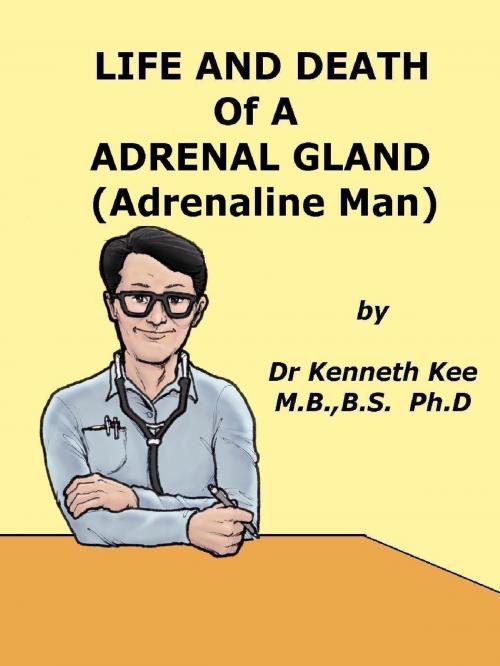Life And Death Of A Adrenal Gland (Adrenaline Man)
Nonfiction, Health & Well Being, Medical, Specialties, Internal Medicine, Endocrinology & Metabolism| Author: | Kenneth Kee | ISBN: | 9781311918253 |
| Publisher: | Kenneth Kee | Publication: | December 19, 2014 |
| Imprint: | Smashwords Edition | Language: | English |
| Author: | Kenneth Kee |
| ISBN: | 9781311918253 |
| Publisher: | Kenneth Kee |
| Publication: | December 19, 2014 |
| Imprint: | Smashwords Edition |
| Language: | English |
My name is Adrenaline Man the Adrenal Gland Cell.
Can you feel the Adrenaline rush?
An adrenaline rush can cause the body to perform and breathe rapidly improving strength of the body.
I was named Adrenaline Man by my friends who feel that Adrenaline Man is the most suitable name of a cell from the Adrenal Gland of the human body.
The only cells in the early human embryo are precursor cells or stem cells that are nudged into becoming specialized bone, nerve, internal organ or adrenal gland by the action of genes and the growth-and-development molecules produced by genes.
It may be surprising to learn that we adrenal gland cells have a developmental relationship with many others tissues such as breast and prostate gland but this shows the built-in potential of stem cells to grow into a variety of specialized forms.
We adrenal gland cells do not just spring into existence from embryo stem cells.
The path of our development begins in a group of progenitor stem cells that are nudged into different directions to become specialized cells of many different tissues and organs including the adrenal gland.
The paraxial mesoderm is divided along the embryo's length into somites, corresponding to the segmentation of the body.
-
Sclerotome (which forms vertebrae),
-
Dermatome (which forms skin),
-
Myotome (which forms muscle).
We adrenal glands are located above and in front of the kidney one on each side.
We adrenal glands consist of 2 layers:
-
My medulla which is the central core of the adrenal is dark red in color
-
My cortex which form three quarters of the gland is deep yellow in color due to the high content of cholesterol inside.
The 2 main parts of my adrenal glands have different embryonic origins.
-
My inside core adrenal medulla is derived from neural crest.
-
The mesenchyme surrounding these cells differentiates to form my fetal cortex.
This fetal cortex is later replaced by my adult cortex.
My outside adrenal cortex is derived from coelomic epithelium (mesoderm).
Numerous buds of cells form from the deep surface of the mesothelium
My cortex is further divided into 3 distinct layers each with distinct hormonal functions:
-
zona glomerulosa form in clusters of my cells,
-
zona fasiculata arranged in radial bands of my cells,
-
zona reticularis form a loose highly vascular network
During fetal development my adrenal hormones are involved with the maturation of the lung and other developing systems.
My cells move in lines through my fetal cortex in a cord-like arrangement without destruction of the cortical architecture.
The steroid production of my adrenal cortex is characterized by early transient cortisol biosynthesis followed by its suppressed synthesis until late gestation.
There is also extensive production of dehydroepiandrosterone (DHEA) and its DHEA sulfate which are precursors of placental estrogen by my adrenal cortex during most of gestation.
My adrenal gland goes through cell proliferation and angiogenesis at the gland periphery, cellular migration, hypertrophy and apoptosis.
TABLE OF CONTENT
Chapter 1 Story of Adrenaline Man
Chapter 2 Life Cycle of Adrenal Gland
Chapter 3 Formation of an Adrenal Gland
Chapter 4 Death of an Adrenal Gland
Chapter 5 Addison’s Disease
My name is Adrenaline Man the Adrenal Gland Cell.
Can you feel the Adrenaline rush?
An adrenaline rush can cause the body to perform and breathe rapidly improving strength of the body.
I was named Adrenaline Man by my friends who feel that Adrenaline Man is the most suitable name of a cell from the Adrenal Gland of the human body.
The only cells in the early human embryo are precursor cells or stem cells that are nudged into becoming specialized bone, nerve, internal organ or adrenal gland by the action of genes and the growth-and-development molecules produced by genes.
It may be surprising to learn that we adrenal gland cells have a developmental relationship with many others tissues such as breast and prostate gland but this shows the built-in potential of stem cells to grow into a variety of specialized forms.
We adrenal gland cells do not just spring into existence from embryo stem cells.
The path of our development begins in a group of progenitor stem cells that are nudged into different directions to become specialized cells of many different tissues and organs including the adrenal gland.
The paraxial mesoderm is divided along the embryo's length into somites, corresponding to the segmentation of the body.
-
Sclerotome (which forms vertebrae),
-
Dermatome (which forms skin),
-
Myotome (which forms muscle).
We adrenal glands are located above and in front of the kidney one on each side.
We adrenal glands consist of 2 layers:
-
My medulla which is the central core of the adrenal is dark red in color
-
My cortex which form three quarters of the gland is deep yellow in color due to the high content of cholesterol inside.
The 2 main parts of my adrenal glands have different embryonic origins.
-
My inside core adrenal medulla is derived from neural crest.
-
The mesenchyme surrounding these cells differentiates to form my fetal cortex.
This fetal cortex is later replaced by my adult cortex.
My outside adrenal cortex is derived from coelomic epithelium (mesoderm).
Numerous buds of cells form from the deep surface of the mesothelium
My cortex is further divided into 3 distinct layers each with distinct hormonal functions:
-
zona glomerulosa form in clusters of my cells,
-
zona fasiculata arranged in radial bands of my cells,
-
zona reticularis form a loose highly vascular network
During fetal development my adrenal hormones are involved with the maturation of the lung and other developing systems.
My cells move in lines through my fetal cortex in a cord-like arrangement without destruction of the cortical architecture.
The steroid production of my adrenal cortex is characterized by early transient cortisol biosynthesis followed by its suppressed synthesis until late gestation.
There is also extensive production of dehydroepiandrosterone (DHEA) and its DHEA sulfate which are precursors of placental estrogen by my adrenal cortex during most of gestation.
My adrenal gland goes through cell proliferation and angiogenesis at the gland periphery, cellular migration, hypertrophy and apoptosis.
TABLE OF CONTENT
Chapter 1 Story of Adrenaline Man
Chapter 2 Life Cycle of Adrenal Gland
Chapter 3 Formation of an Adrenal Gland
Chapter 4 Death of an Adrenal Gland
Chapter 5 Addison’s Disease















